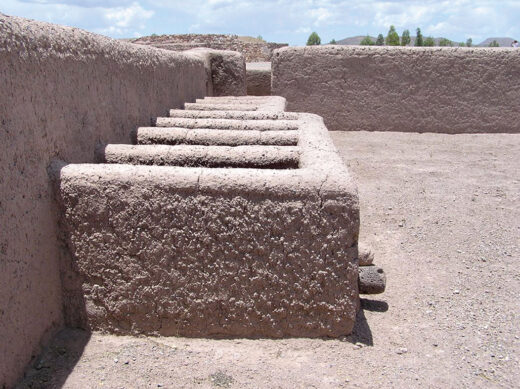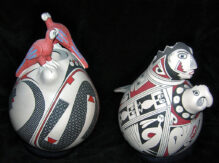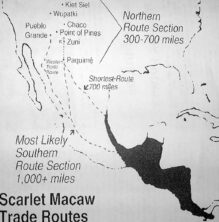Ron and Vicki Sullivan
Scarlet macaws may have been the first rain birds to arrive in the desert oasis southwest. Originating in the humid tropical lowlands of southern Mexico, scarlet macaws were transported a minimum of 700 miles up to a total of 1400 miles. One of the 700 mile legs was from Mesoamerica to the ancient village of Paquimé, also known as Casas Grandes, in northwestern Chihuahua, Mexico (Figure one).
Approximately 15 miles from the archaeological site of Paquimé is the village of Juan Mata Ortiz, commonly known as Mata Ortiz. From the late 1950s Mata Ortiz potters have been collecting pre-Hispanic pottery shards and inspired by images from cave art paintings in the nearby mountains. These ancestral symbols have created a unique artistic language the potters use in their contemporary art forms.
Many of these realistic and abstract symbols are scarlet macaws. Paquimé was an important trade route between Mesoamerica and the southwestern United States. The people of Paquimé raised macaws for their vividly colored red, yellow and blue feathers that were used in religious dress, trade and burial ceremonies.
Scarlet macaws require intensive care. They hatch in March and must be removed from the nest at seven weeks of age. They must be carried in baskets, protected from chilling and fed chewed hominy, often straight from the keeper’s mouth, every few hours day and night.
In 1958 the Amerind Foundation from Dragoon, Arizona, and Instituto Nacional de Antroplogía e Historia (INAH) initiated the Joint Paquimé/Casas Grandes Project (1958 to 1961). Structures designed as nesting boxes for the scarlet macaws, photographed in Figure 2, were excavated and preserved at the site.
Contemporary potters, such as Jeraldo Jera Tena and his wife Norma Hernandez, second generation master potters from Barrio Porvenir in Mata Ortiz, use these ancient macaw images in their slip and clay designs. Their art is exhibited and collected throughout North America. Several of Jera’s and Norma’s works are included in the Sullivan Art Collection (Figure 3).
The Sullivans are residents of Quail Creek. They are involved with projects which preserve, promote and build on the cultural and artistic heritage of Mata Ortiz pottery tradition through education, cross border awareness and economic opportunities.
For more information, visit their website at www.mataortizconnection.com.



